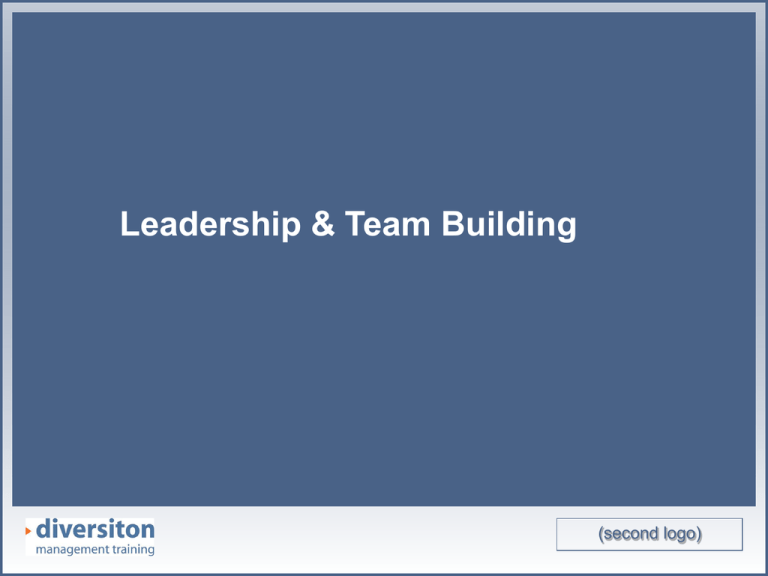Module 2 Leadership & Team Building
advertisement

Leadership & Team Building Leadership & Team Building (second logo) Leadership & Team Building Contrasting the Two Styles Directive 1. You alone are responsible. Tells people what to do. 2. You assume you know the best way. 3. People receive little feedback. 4. Mid-course correction is difficult. Top-down communication. 5. Goals are not widely shared. Collaborative 1. You ask others to help. There is a lot of communication and people can express their views. 2. Responsibility is shared. Helps the team to discover / decide what to do. 3. There is flexibility and it is easy to shift direction. 4. Two-way communication. 5. Everyone shares the goal. (second logo) Leadership & Team Building As a Facilitator you have to: • • • • • • • • Help people to learn, grow and develop. Help people to work together. Share information and be a communication link. Encourage & help people to take responsibility & problem solve, not to point the finger & blame others. Encourage people to seek new ideas & possibilities. Recognise and reward team success. Be a teacher, an encourager, a coach. Learn to step back and allow people to learn, grow, develop, contribute and excel. (second logo) Leadership & Team Building Teams Work Best When • • • • • • • Everyone joins in. Everyone is willing to listen and really consider other people’s point of view. Everyone is pulling in the same direction. Everyone feels they can share their ideas and concerns without feeling that others may think them “unimportant” or “silly”. Everyone can accept that other people’s ideas and solutions may be okay, even though you would have done it differently. Everyone believes that teams can make a difference, that they really will be listened to and can change things. Everyone accepts responsibility for moving forward. (second logo) Leadership & Team Building Why Use Teams? Help to make decisions Find solutions to problems Take the initiative Be accountable for results (second logo) Leadership & Team Building • Teamwork is about delegation and empowerment. • As a manager you have to give up power and control over your people to gain higher effectiveness, motivation and productivity. • Team working and empowerment is a different way of people working together. (second logo) Leadership & Team Building Checking Empowerment Signs of an unempowered workplace: •People aren’t very interested in their work. •People feel negative. •People only do what they are supposed to do. •Nobody says what is on their mind. •People are suspicious. •People aren’t willing to help out. (second logo) Leadership & Team Building Unempowered employees have the following feelings: •They don’t matter. •No-one is really interested in their ideas. •They have little or no control over what they do. •Only a small amount of their skills and energy are used. (second logo) Leadership & Team Building Empowered employees have the following feelings: They feel they make a difference. They are responsible for their results. They are part of a team. They can use their full talents and abilities. They have control over how they do their jobs. They use their initiative. (second logo) Leadership & Team Building Building a Team Example Suppose you want to encourage your team to be more involved in decision-making. The steps you take might be something like: (second logo) Leadership & Team Building • Step 5. Delegate. • • Ask the team to decide. They take control. Step 4. Collaboration. Reach a decision that everyone likes. Everyone takes full responsibility. Step 3. Dialogue. Discuss each issue thoroughly before you decide. Everybody then goes along with the decision. (second logo) Leadership & Team Building • Step 2. Input. You ask for input before you make a decision and listen to inputs. • Step 1. Directive. You tell people what you have decided. Ask what they think about it. (second logo) Leadership & Team Building 6 Things Teams Need To Be Effective 1. Clear Targets No team can operate effectively unless its members know what its objectives are. 2. Adequate Resources A team can only carry out its tasks effective if it has the resources it needs. These may take many forms – financial, material, people/skills, meeting accommodation and so on. (second logo) Leadership & Team Building 3. Reliable Information Teams need information to carry out work tasks, to contribute to problem solving and decision-making, to plan for new developments or changes, to work effectively with other departments/ functions etc. (second logo) Leadership & Team Building 4. Training & Development Teams have an ongoing need for training and development - to address short-falls in performance, to add skills or knowledge, to develop problem solving capability, to enhance the quality of teamwork etc. Very often this may take the form of on-the-job training or coaching from a supervisor. (second logo) Leadership & Team Building 5. Regular Feedback and Recognition Teams need to know the results their efforts achieved against different performance indicators. Feedback gives the team the opportunity to manage their future performance. They also need organisational recognition for their achievements. (second logo) Leadership & Team Building 6. Technical and Process Assistance Any working team will require a certain amount of technical support to carry out its task effectively. This might include support for process management, HR, finance, Health & Safety and so on. (second logo) Leadership & Team Building Team Development at DHL In your team, discuss the following questions: 1. What changes could you make to encourage effective Team Working at DHL? (second logo) Leadership & Team Building 2. How will you set about making these changes outside of this training. (For some it will be relevant to consider such questions as: Is this something I/we can just get on with? Who else needs to be involved/give approval? What time-scale(s) are appropriate? How can we make sure we take people with us – and don’t frighten them off? And so on). (second logo) Leadership & Team Building THE TIME OF YOUR LIFE! Rules for completing time logs! Select any two work days before the next module. Choose typical days, rather than a day when you are involved in exceptional or infrequent activities. (second logo) Leadership & Team Building From the moment you arrive at work until the time you leave, record how you spend your time. Record everything in as much detail as possible – phone calls, meetings, conversations with colleagues about work, social conversations, breaks and so on. Try not to do anything differently just because you are completing your log. Your log is to help you get the best from the training module – no-one will be examining it but you. (second logo)






